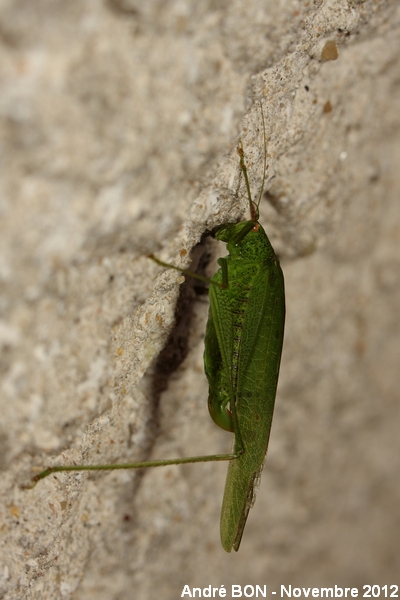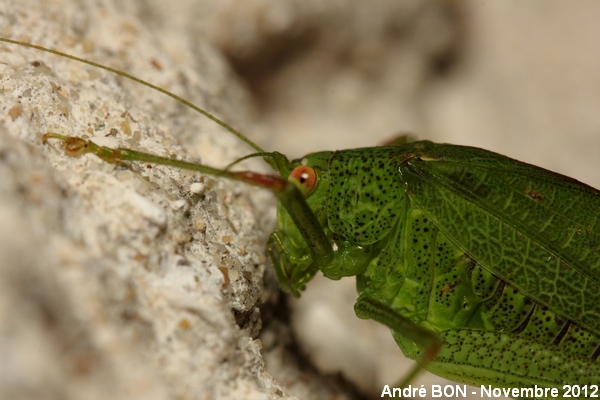

| Mediterranean Katydid (Phaneroptera nana (Fieber, 1853)) |


|
|
Scientific name: Phaneroptera nana (Fieber, 1853) Common name: Mediterranean Katydid French name: Phanéroptère méridional Order: Orthoptera Family: Phaneropteridae Wingspan : 12-15 mm. Biotope: Dry and sunny places, bushes, waste lands, open woodlands. Geographic area: Southern Europe north to northern France and to southern Germany, east to Georgia, extending its range northwards. North Africa, Near-East. Introduced to California. Observation period : July to October. |
The Mediterranean Katydid is a medium size grasshopper with a pale green body covered with black spots. It can be identified by its wings which are much longer than the elytra. The pronotum side plates are rounded. The length of the antenna can reach four times the length of the body. The female's abdomen ends with a regularly upturned ovipositor with a regular (non-wavy) baseline. The male's sub-genital plate ends with two short straight points. The Mediterranean Katydid mainly feeds on plants. Females lay the eggs on shrub's leaves. It is difficult to differentiate from the Sickle-bearing Bush-cricket (Phaneroptera falcata), whose range is extending further north. The clues which can help to tell apart both species are: - The Sickle-bearing Bush-cricket has thinner thighs. - The female Mediterranean Katydid's ovipositor shows a continuous curve with a regular baseline, the female Sickle-bearing Bush-cricket's ovipositor shows a sharp right angle turn with a slightly wavy baseline. - The male Mediterranean Katydid's sub-genital plate ends with two short straight points. They are diverging on male Sickle-bearing Bush-cricket. - On a side view, the Sickle-bearing Bush-cricket pronotum's width is longer than its height, the Mediterranean Katydid's pronotum is higher with a shorter width. |
| [To know more about the Mediterranean Katydid] [Next picture] [Top] |

|
I have hesitated during a long time about the identification of this specimen, trying to evaluate all the criteria allowing to tell the Mediterranean Katydid and Sickle-bearing Bush-cricket species apart. I have finally chosen the Mediterranean Katydid species based on the hind leg thighs which are clearly larger than the one I am used to seeing on Sickle-bearing Bush-crickets. I have not been able to use the shape of the side plates of the pronotum nor the curve shape of the ovipositor. Maybe I am lacking some experience ... |
| [To know more about the Mediterranean Katydid] [Previous picture] [Top] |

|
Here is a close-up view showing the side plate of the pronotum. |